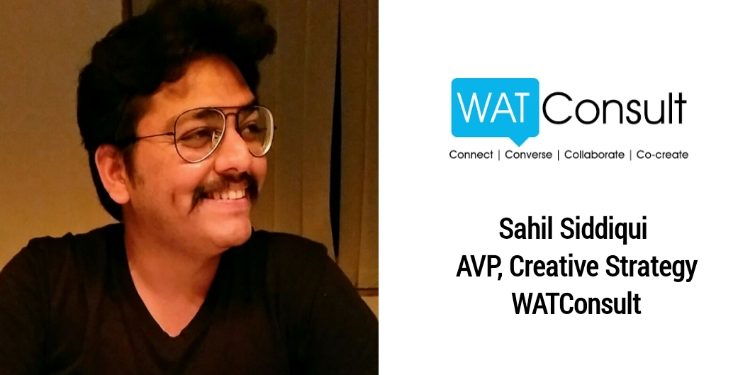Sahil Siddiqui, AVP, Creative Strategy at WATConsult, is a software engineer by education and made the switch to digital marketing owing to a natural inclination towards creative expression and lateral thinking.
With over 9 years of experience in the digital landscape, Sahil has helped more than 100 brands convey the right message in the right voice. Give subtitles to campaigns such as, Bajaj Alliance Unplanned, SBI Life Thanks a Dot, Beat the Crave Saffola fittify are some of his memorable works.
Siddiqui loves writing, drawing, sketching and is a good orator. He likes to bring humor in his communication and believes that’s what makes him stand apart.
In a conversation with Medianews4u, Sahil Siddiqui, AVP, Creative Strategy, WATConsult, spoke about his learnings, growth and much more:
How was the last year? What were some of the key objectives that you had set out to achieve?
2019 was a year with a lot of activity for us as well as the entire industry, the year began with the big promise of video and OTT platforms seen anew from the emerging rural Indian voice. We had a year filled with opportunity and experimentation.
Our objectives were to explore digital effective for big ideas in 2019, irrespective of the primary platform. We had gone in all directions to realize this vision, right from platform-based engagement innovation like Insta Badges with Nikon, to rural outreach cause marketing Thanks a Dot with SBI Life Insurance. From shockvertising IdeaChor with MX player to creative media effectiveness in Mind Your Language campaign with Racold, it had been a fruitful year where creative, media and effectiveness came together.
While advertisers are currently spending most on digital mediums, the question that arises is will advertisers ever overlook traditional for digital or will the two continue to co-exist without getting into a debate?
While we’ve seen ~30%(+- 5%) growth in spending on digital this year in India, it’s to be expected from an emerging market like ours. Overlooking traditional is not a recommendation even we, as a full-function digital agency, make for our partners. ‘Co-existing’ too sounds like a compromise given the confrontational nature of the historical conversations around mainline v/s digital.
I think good sense needs to prevail. Mainline does what the mainline does. Digital does what digital does.
Each can (and should) augment each other. It’s about reaching the right people at the right place at the right time at the right price at the end of the day. Whoever internalizes this first, will be better off.
How have brands evolved when it comes to spending on digital as compared to traditional spends on TV/Print?
Digital spending has always been more agile and brands have shown full acknowledgment of the changing digital consumer landscape. Many projected trends have gone mainstream in 2019 and it’s been great to see them reflected in spending patterns. Brands have slowly but steadily evolved to acknowledge the changing trends and behaviors.
Since digital is an ever-evolving medium, which is some of the key trends you had spotted in 2019, exclusively?
• Vernacular content creation.
• Focus on video format innovations
• Testing viability of alternate platforms like TikTok
• Mainstreaming of local OTT platforms have
• The emergence of the Facebook ecosystem
• Sales and Conversion attribution to digital
How are brands leveraging the adaptation of IoT, AI, ML? What’s the way forward?
AI and ML found immediate application and success in media and planning and optimization. IoT is waiting for 5G to arrive and only then will its true potential be realized at scale. AI and ML will make the leap to the real-world in the form of contextualization and personalization in real-time. Way forward for IoT is going to be dictated by infrastructure and in preparation, the marketing community should get the consumer-ready for newer experiences.
How has Augmented Reality and Virtual Reality based marketing solutions worked for Indian brands?
Education, interior designing and couponing systems have been the early adopters of AR and VR already. It’s still early to categorically classify AR/VR as a success or failure. It represents potential still, but its effectiveness will come from the acceptance of technology and UX, which will mostly be driven by breakthrough consumer and business products first, followed by marketing.
India is now a mobile-first country, how are you leveraging this to the benefit of your clients?
Paradigm shifts in platform behavior happen every few years in marketing. Mobile has been touted as the next leap for a few years now. Its arrival has made short, instant and contextual has to become the rule for effective delivery of creative. While older strategies aimed at scaling up, in the mobile world, we will be talking the language of scaling down done en-masse.

















